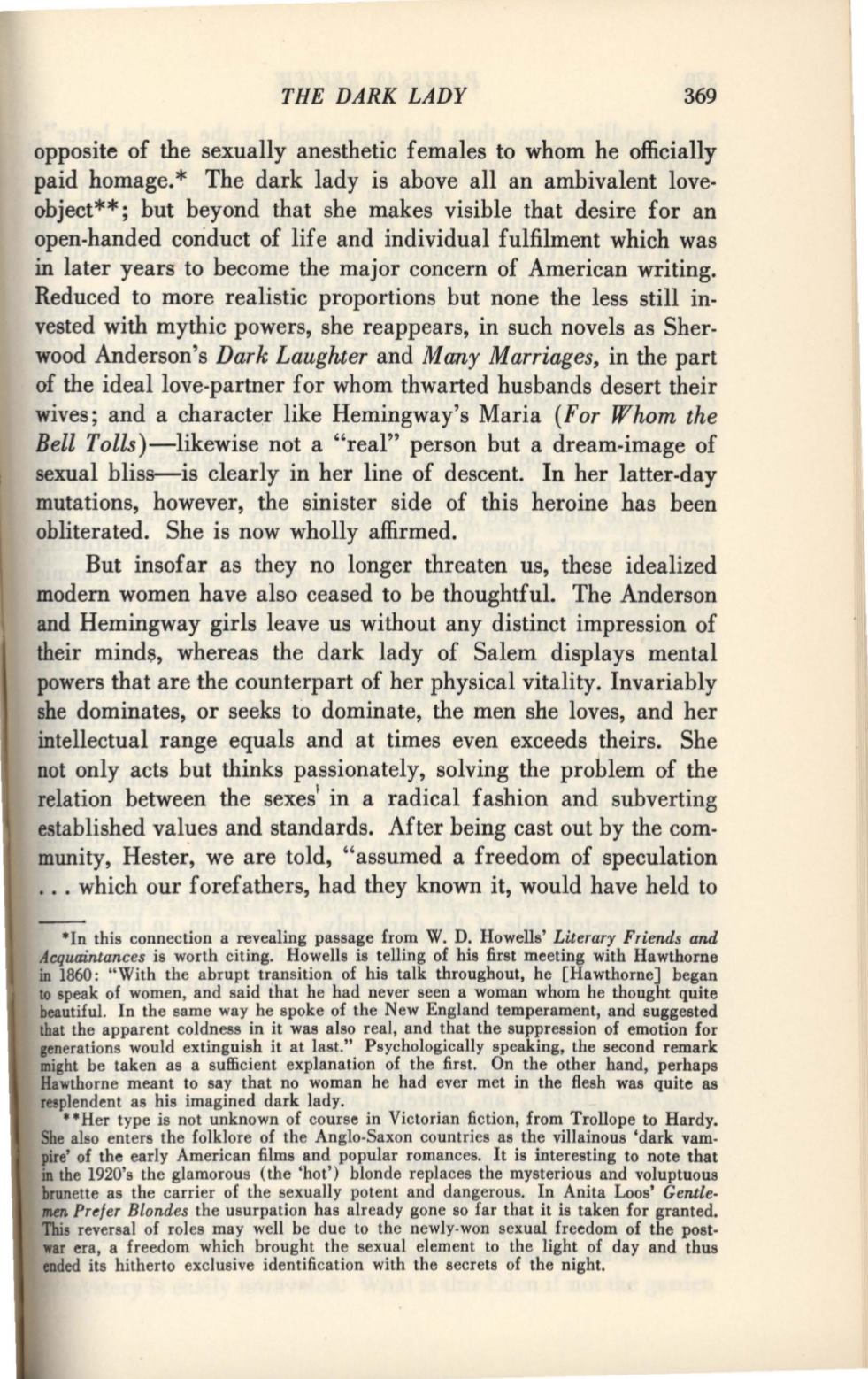
THE DARK LADY
369
opposite of the sexually anesthetic females to whom he officially
paid homage.* The dark lady is above all an ambivalent love–
object**; but beyond that she makes visible that desire for an
open-handed conduct of life and individual fulfilment which was
in later years to become the major concern of American writing.
Reduced to more realistic proportions but none the less still in–
vested with mythic powers, she reappears, in such novels as Sher–
wood Anderson's
Dark Laughter
and
Many Marriages,
in the part
of the ideal love-partner for whom thwarted husbands desert their
wives; and a character like Hemingway's Maria
(For Whom the
Bell Tolls
)-likewise not a "real" person but a dream-image of
sexual bliss-is clearly in her line of descent. In her latter-day
mutations, however, the sinister side of this heroine has been
obliterated. She is now wholly affirmed.
But insofar as they no longer threaten us, these idealized
modern women have also ceased to be thoughtful. The Anderson
and Hemingway girls leave us without any distinct impression of
their minds, whereas the dark lady of Salem displays mental
powers that are the counterpart of her physical vitality. Invariably
she dominates, or seeks to dominate, the men she loves, and her
intellectual range equals and at times even exceeds theirs. She
not only acts but thinks passionately, solving the problem of the
relation between the sexes
1
in a radical fashion and subverting
established values and standards. After being cast out by the com–
munity, Hester, we are told, "assumed a freedom of speculation
... which our forefathers, had they known it, would have held to
*In this connection a revealing passage from W. D. Howells'
Literary Friends
and
Acquaintances
is worth citing. Howells is telling of his first meeting with Hawthorne
in
1860: "With the abrupt transition of his talk throughout, he [Hawthorne] began
to
speak of women, and said that he had never seen a woman whom he thought quite
beautiful. In the same way he spoke of the New England temperament, and suggested
that the apparent coldness in it was also real, and that the suppression of emotion for
generations would extinguish it at last." Psychologically speaking, the second remark
might be taken as a sufficient explanation of the first. On the other hand, perhaps
Hawthorne meant to say that no woman he had ever met in the flesh was quite as
resplendent as his imagined dark lady.
• *Her type is not unknown of course in Victorian fiction, from Trollope to Hardy.
She also enters the folklore of the Anglo-Saxon countries as the villainous 'dark vam·
pire' of the early American films and popular romances. It is interesting to note that
in
the 1920's the glamorous (the 'hot') blonde replaces the mysterious and voluptuous
brunette as the carrier of the sexually potent and dangerous. In Anita Loos'
Gentle–
men Prefer Blondes
the usurpation has already gone so far that it is taken for granted.
This reversal of roles may well be due to the newly-won sexual freedom of the post–
war era, a freedom which brought the sexual element to the light of day and thus
ended its hitherto exclusive identification with the secrets of the night.


